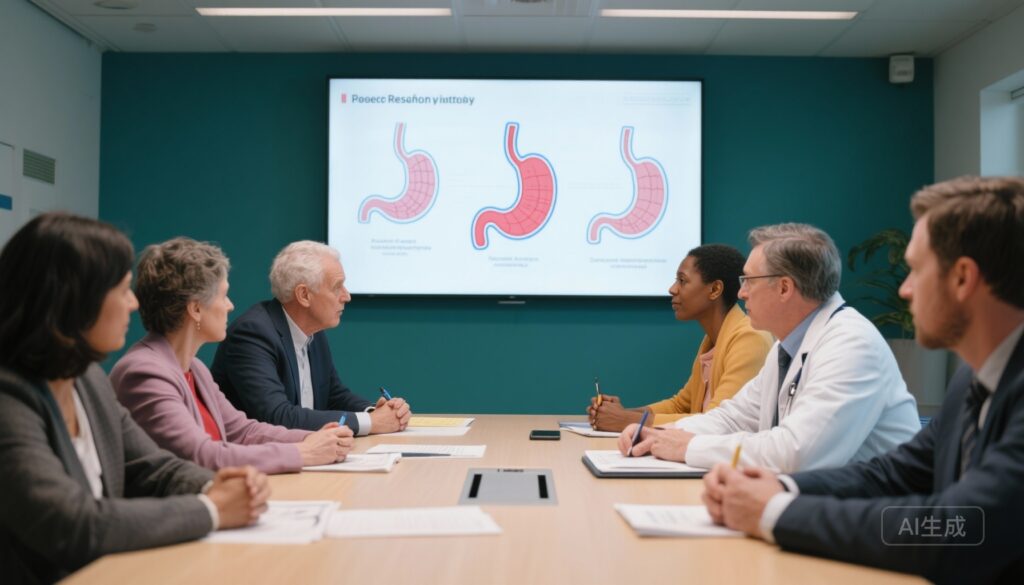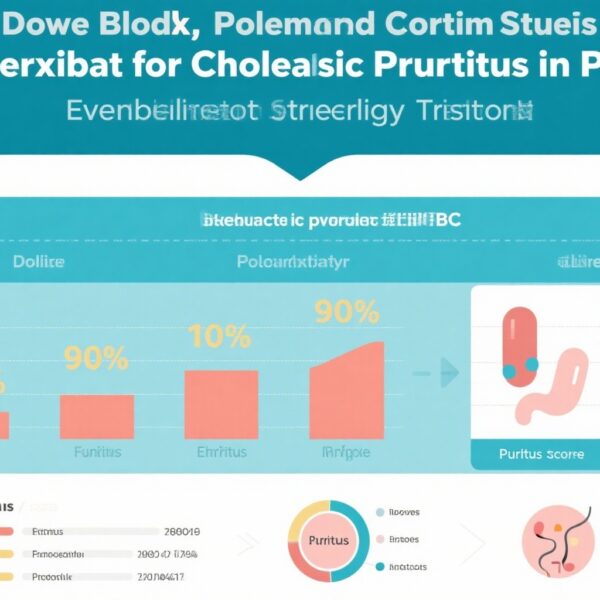Introduction and Context
Cancers of the oesophagus and stomach (oesophagogastric cancers) remain a global cause of substantial morbidity and mortality despite recent therapeutic advances. In high‑income countries, multimodality care—combining surgery, systemic therapy and radiotherapy—has improved outcomes for some patients, but survival remains poor for many, and treatment causes major functional and nutritional consequences. Research investment must therefore be aligned to questions that will most improve outcomes that matter to patients: survival, function, symptom control and quality of life.
To ensure research addresses those priorities, Jones and colleagues led a UK and Ireland partnership exercise—reported in Gut (2025)—to gather, verify and prioritise research uncertainties for oesophagogastric cancers using inputs from patients, carers and a wide range of healthcare professionals (HCPs). The exercise generated a robust, patient‑weighted shortlist intended to guide funders, policy makers and investigators toward impactful studies.
Why this consensus was needed now
Several forces made this work timely:
– Rapid evolution of systemic therapies (notably immunotherapy and targeted agents) and increasing complexity of multimodality regimens raised new questions about optimal sequencing and patient selection.
– Growing recognition of the importance of patient‑centred outcomes—nutrition, swallowing, pain control, psychosocial support and survivorship—versus purely disease‑focused endpoints.
– Limited funding and research capacity mean prioritisation can maximise impact.
– Increasing expectations that research agendas be co‑designed with patients and front‑line clinicians.
The authors therefore set out to capture the research questions considered most important by those living with oesophagogastric cancers and the clinicians who treat them, and to confirm which suggested questions were true uncertainties (not already resolved by evidence).
Key reference: Jones CM et al. Research priorities for cancers of the oesophagus and stomach: recommendations from a UK and Ireland patient and healthcare professional partnership exercise. Gut. 2025. doi:10.1136/gutjnl-2025-336421.
New consensus highlights — what the partnership concluded
The exercise collected 4,295 suggested uncertainties from 835 respondents (440 patients/carers and 395 HCPs across 25 professional groups). These were consolidated to 92 verified research uncertainties and then prioritised by an interdisciplinary HCP group; final rankings were weighted by a separate patient survey to ensure patient values influenced the order.
Major themes from the 20 highest‑priority questions include:
– Personalising and optimally combining treatment modalities (5 of the top 20). Examples: determining which patients benefit from neoadjuvant or adjuvant therapy, the role and timing of surgery in the era of effective systemic therapy, and optimal combinations of chemo-, radio- and immunotherapy.
– Nutrition and physiological support: how best to prevent, detect and treat cancer‑related malnutrition and to support swallowing and intake during and after treatment.
– Improving quality of life (QoL) and symptom control both during active treatment and for patients not cured of their disease (palliative care and survivorship priorities).
– Diagnosis and staging improvements, and evaluation of surveillance strategies after curative‑intent treatment.
A striking quantitative finding: incorporating patient weighting altered HCP‑derived rankings by 22.2–46.3% — demonstrating that patient input materially changed which questions were prioritised.
How the partnership worked (methods in brief)
– Scoping survey: Open call to patients, carers and HCPs across the UK and Ireland to list perceived research uncertainties across prevention, diagnosis/staging, treatment, palliative care and survivorship. 835 total survey respondents contributed.
– Consolidation and evidence check: Submitted questions were grouped, refined and checked against systematic reviews and guideline literature to ensure they were true uncertainties (i.e., unanswered by current high‑quality evidence).
– Prioritisation: An interdisciplinary HCP group scored the 92 verified uncertainties for potential impact. A separate patient survey provided weighting to re‑rank priorities to reflect patient perspectives.
The process follows closely the James Lind Alliance (JLA) priority‑setting partnership approach, which emphasises co‑production with patients and end‑users of research.
Reference for JLA methodology: James Lind Alliance. The JLA Guidebook (latest edition). Available: https://www.jla.nihr.ac.uk/guidebook/
Updated recommendations and key changes (compared with previous research agendas)
This work is not a clinical practice guideline; rather, it is a priority‑setting consensus designed to steer future research. Important features and departures from prior, more expert‑led research agendas include:
– Patient weighting: previous priority lists were often clinician‑centred; this exercise demonstrates substantial re‑ordering when patient priorities are counted.
– Broader scope: equal emphasis across prevention, staging, active treatment, palliative care and survivorship—whereas many prior agendas focused mainly on therapeutic innovations.
– Emphasis on pragmatic, implementable questions: many top priorities ask not just “what works?” but “for whom, when and at what cost/impact on function?”
The net effect is a research agenda that balances innovation (new drugs and modalities) with improvements in supportive care, nutrition and QoL that patients reported as highly important.
Topic‑by‑topic priorities and recommended research directions
Below we summarise the consensus priorities and suggest how they could be translated into studies. The headings mirror the domains used in the partnership.
Prevention and early detection
– Priority uncertainties: identifying modifiable risk factors and effective, acceptable approaches to screening/high‑risk surveillance.
– Recommended research: population and high‑risk cohort studies to test targeted surveillance strategies; evaluation of biomarkers (blood, breath, endoscopic imaging) for early detection.
Diagnosis and staging
– Priority uncertainties: improving accuracy of staging to avoid under‑ or overtreatment; better imaging and endoscopic methods to predict response to therapy.
– Recommended research: prospective studies comparing advanced imaging (PET‑CT, MRI) and endoscopic techniques with pathological outcomes; development and validation of response biomarkers.
Treatment (curative intent and advanced disease)
– Priority uncertainties (top 5 themes): personalising multimodality care; optimal sequencing and combinations of surgery, systemic therapy and radiotherapy; selection markers for immunotherapy/targeted agents.
– Recommended research: adaptive trial platforms and pragmatic RCTs comparing contemporary multimodality strategies, with embedded translational biomarker studies to identify predictive markers of benefit and toxicity.
– Evidence grading: many of these remain evidence gaps (no high‑quality RCTs addressing specific sequencing or combinations in all subgroups), hence high priority for randomized evaluation.
Nutrition, function and quality of life
– Priority uncertainties: best interventions to prevent and treat cancer‑related malnutrition and dysphagia; timing and type of feeding access; rehabilitation strategies post‑treatment.
– Recommended research: randomized and pragmatic trials of nutritional pathways (e.g., proactive dietitian‑led interventions, early enteral feeding vs as‑needed), swallowing rehabilitation trials, and incorporation of nutrition endpoints into therapeutic trials.
Palliative care and survivorship
– Priority uncertainties: optimizing symptom control, advance care planning, psychosocial support, and long‑term survivorship care models.
– Recommended research: trials of early integrated palliative care, interventions to improve long‑term function and QoL, and comparative evaluation of follow‑up models.
Cross‑cutting priorities
– Incorporate patient‑reported outcomes (PROs) and core outcome sets into every trial.
– Use inclusive trial designs that enrol older adults and those with comorbidities to increase generalisability.
– Build translational substudies to link molecular features to outcomes and treatment response.
Expert commentary: interpretation, controversies and implications
Panel insights from the authors and interdisciplinary contributors highlight several practical points:
– Patient perspectives shift priorities toward everyday problems (nutrition, swallowing, QoL) that are frequently under‑researched relative to drug development. Investing in these areas could deliver rapid improvements in patient experience even if survival gains remain incremental.
– Personalisation of therapy remains a top priority—experts argue that the era of ‘one‑size‑fits‑all’ multimodality regimens is ending. However, robust predictive biomarkers are still lacking; pragmatic, biomarker‑embedded trials are needed.
– There is potential tension between research that advances curative treatments for early‑stage disease and research that improves palliation for those with incurable disease. The partnership explicitly prioritised both, reflecting a desire to improve outcomes across the disease spectrum.
– Methodologically, the group favoured adaptive and platform trials to efficiently compare multiple strategies and integrate translational discovery; funders and regulators should support such flexible designs.
Controversies include how to prioritise scarce funding across high‑cost drug trials versus lower‑cost supportive care research: some stakeholders worry that industry funding skews agendas toward therapeutics, while patient input favors quality‑of‑life research. The partnership’s transparent, mixed stakeholder approach provides a counterbalance by elevating patient priorities.
Practical implications for clinicians, researchers and funders
– For researchers: use the published priority list to design grant proposals that address high‑impact, patient‑endorsed uncertainties. Embed PROs, nutritional endpoints and translational biomarkers into study protocols.
– For funders: prioritise calls that match the consensus list—especially pragmatic trials of multimodality sequencing, nutrition interventions and QoL‑focused studies—and underwrite adaptive platform trials that can answer multiple linked questions.
– For clinicians: advocate for inclusion of patient‑valued outcomes in local research and quality improvement; engage patients in research co‑design.
Implementation checklist for research teams
– Register and map your research question to the priority list from Jones et al. 2025.
– Include patient partners from protocol design through dissemination.
– Ensure trials collect core PROs and nutrition metrics; consider health economic endpoints.
– Use adaptive designs when appropriate and plan translational biobanking.
Limitations and future directions
The partnership exercise was robust but not without limits: participants were UK and Ireland‑based, which may limit generalisability to other health systems. Some groups (e.g., minority ethnic communities or certain allied health professions) may have been under‑represented despite reasonable breadth of HCP respondents. Future updates should aim to broaden geographical and demographic representation and to track progress against the priorities identified.
The authors and many respondents also called for routine monitoring of how research funding aligns with these priorities and for the development of core outcome sets (e.g., via COMET) to standardise outcomes across trials.
Conclusion
The UK–Ireland patient and HCP partnership exercise reported by Jones et al. provides a clear, patient‑weighted roadmap for research into oesophageal and stomach cancers. Its major messages are: (1) patients materially change research priorities when their views are weighted; (2) priorities extend beyond novel drugs to include nutrition, function and QoL; and (3) future research should favour pragmatic, adaptive designs with embedded biomarkers and patient‑reported outcomes. Funders, investigators and clinical networks should use this consensus to direct resources to work that patients and clinicians agree will provide the greatest benefit.
Selected references
– Jones CM, Ng WH, Tincknell L, et al. Research priorities for cancers of the oesophagus and stomach: recommendations from a UK and Ireland patient and healthcare professional partnership exercise. Gut. 2025 Sep 14:gutjnl-2025-336421. doi:10.1136/gutjnl-2025-336421. PMID: 40947137.
– James Lind Alliance. JLA Guidebook. (Accessed 2024). https://www.jla.nihr.ac.uk/guidebook/
– Smyth EC, Nilsson M, Grabsch HI, van Grieken NC, Lordick F. Gastric cancer. Lancet. 2020;396(10251):635–648. doi:10.1016/S0140-6736(20)31288-4.
– Sung H, Ferlay J, Siegel RL, et al. Global Cancer Statistics 2020: GLOBOCAN Estimates of Incidence and Mortality Worldwide for 36 Cancers in 185 Countries. CA Cancer J Clin. 2021;71(3):209–249. doi:10.3322/caac.21660.
Thumbnail prompt
A diverse panel of patients and clinicians seated at a round table, reviewing printed research priorities with anatomical illustrations of the oesophagus and stomach on a screen in the background; warm, collaborative lighting, modern conference room setting.



